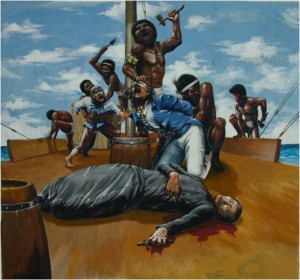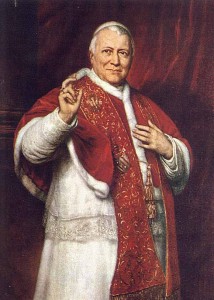PIME (The Pontifical Institute for Foreign Missions) came into being on July 30, 1850, at Saronno (Milan). It came forth from the great heart of Pius IX, who gave a vigorous push for the “foreign missions.” In spite of the enormous difficulties of his pontificate, Pius IX desired that an institute of secular clergy and laymen similar to the model of the “Foreign Missions” of Paris come to birth in Italy. The latter society was the right arm of Propaganda Fide in Asia. In 1847, the Pope informed the Archbishop of Milan, Archbishop Romilli that an Italian missionary seminary should be created in the Lombard region.
The proposal fell on fertile ground. The birth of the “Propagation of the Faith” in Lyons (1822) and its initiatives and popular magazines had already set the hearts of the young clergy of the Milanese jurisdiction on fire. Father Angelo Ramazzotti, the superior of the Oblates of Rho, had felt a strong love for the missions from the time of his boyhood, and he had encouraged some young clerics and priests to aspire to the mission apostolate by sending them to religious congregations and orders. He offered himself to Archbishop Romilli and began the “Lombard Seminary for the Foreign Missions” in his father’s house in Saronno together with the first five Milanese priests and two laymen. (In 1851, it was moved to Milan.)
The “Mission Seminary” had its “baptism” by the bishops’ conference of the Lombard region. The bishops signed the act of foundation on December 1, 1850. The Cardinal emeritus of Milan, Cardinal Martini, has said that the text “expresses the theology of the local Church and its missionary nature in terms which anticipate Vatican II. As a matter of fact, those bishops stated that they were not “held back by the fear of losing some subject from the needs of the diocese.” On the contrary, “the spread of the universal Church is the concern of every individual church, and every diocese is in some way responsible to provide its contingent in the apostolic army for this purpose.” Thus it happened that they began their “Provincial Seminary” for the missions with the hope that “also in other places, especially where the clergy is abundant, the bishops will open up for their young ecclesiastics in a favourable way this career … and form such provincial institutes for the testing, formation, and assistance to those aspiring to the foreign missions.”
 It was a modest beginning, but there was a great spirit of giving to the “most distant and abandoned peoples.” It is a fact that the first seven missionaries chose to go to two small islands (Rook and Woodlark) in Oceania. These had been given up by the Marist missionaries; the people were living in the stone age. The new missionaries had to withdraw from the mission after three years and two deaths; one of them was the martyr John Mazzucconi, who was beatified in 1984. The charism of going to the farthest frontiers of Christianity has remained as a precious heritage from the time of the foundation, and it has been evident many times when missions that had been either abandoned or refused by others were then accepted from the Holy See.
It was a modest beginning, but there was a great spirit of giving to the “most distant and abandoned peoples.” It is a fact that the first seven missionaries chose to go to two small islands (Rook and Woodlark) in Oceania. These had been given up by the Marist missionaries; the people were living in the stone age. The new missionaries had to withdraw from the mission after three years and two deaths; one of them was the martyr John Mazzucconi, who was beatified in 1984. The charism of going to the farthest frontiers of Christianity has remained as a precious heritage from the time of the foundation, and it has been evident many times when missions that had been either abandoned or refused by others were then accepted from the Holy See.
The Lombard Seminary for the foreign missions was born in order to send diocesan priests and laymen to the missions, hence it is at the beginning of the modern missionary movement in the Italian church, which has advanced by various means: the diffusion of the Work of the Propagation of the Faith and the Holy Infancy, the foundation of the Missionary Union of the Clergy (1916), the involvement of bishops, priests and seminaries in the mission to the non-Christians, the model and encouragement for the foundation of other missionary institutes, the birth of the first Italian mission magazine (“Le Missioni Cattoliche” in 1872, which today is “Mondo e Missione”).
 As the Pontifical Institute for Foreign Missions, PIME was born at the will of another Pope, Pius XI. In 1926 he united the Lombard Seminary for the Foreign Missions with the Pontifical Seminary of the Holy Apostles Peter and Paul for the Foreign Missions. It was founded in Rome in 1871 by Msgr. Pietro Avanzini with characteristics similar to those of the Milan group. It had been approved by Pope Pius IX in 1874. It had sent members to China, Mexico, Australia, Sudan, Egypt, and also the United States in the service of local churches. From the very beginning, the two mission seminaries had the goal of sending diocesan priests to the missions (the Lombard seminary was sending laymen as well) but without making them religious (“Fidei Donum” priests –one century earlier!). The sole purpose was the first proclamation of the Gospel and foundation of local churches in regions entrusted to them by Propaganda Fide: the mission “ad gentes” (to the non-Christians).
As the Pontifical Institute for Foreign Missions, PIME was born at the will of another Pope, Pius XI. In 1926 he united the Lombard Seminary for the Foreign Missions with the Pontifical Seminary of the Holy Apostles Peter and Paul for the Foreign Missions. It was founded in Rome in 1871 by Msgr. Pietro Avanzini with characteristics similar to those of the Milan group. It had been approved by Pope Pius IX in 1874. It had sent members to China, Mexico, Australia, Sudan, Egypt, and also the United States in the service of local churches. From the very beginning, the two mission seminaries had the goal of sending diocesan priests to the missions (the Lombard seminary was sending laymen as well) but without making them religious (“Fidei Donum” priests –one century earlier!). The sole purpose was the first proclamation of the Gospel and foundation of local churches in regions entrusted to them by Propaganda Fide: the mission “ad gentes” (to the non-Christians).

